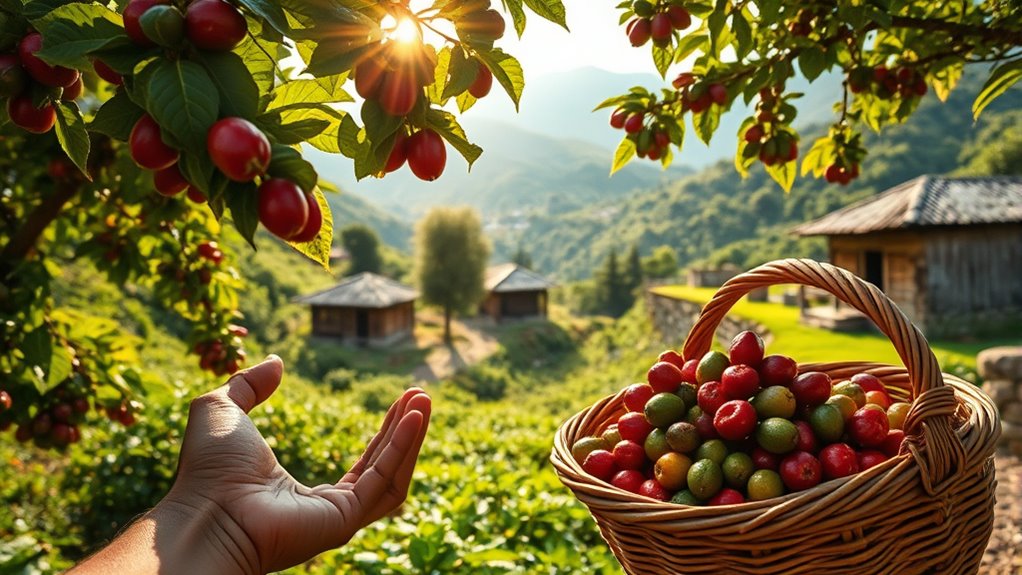Coffee’s origins trace back to Ethiopia’s Kefa region in the 9th century, where the legend of Kaldi and his energizing goats began. By the 15th century, it spread to Yemen, fueling Sufi monks during prayers and sparking the rise of vibrant coffeehouses. As it reached Europe in the late 16th century, its popularity soared, especially after Pope Clement VIII endorsed it. This fascinating journey didn’t stop there, and there’s much more to explore about coffee’s cultural impact.
Key Takeaways
- Coffee originated in the 9th century CE in Ethiopia’s Kefa region, discovered by goat herder Kaldi observing his goats’ energizing reaction to coffee cherries.
- By the 15th century, Sufi monks in Yemen brewed coffee to enhance wakefulness during prayers, leading to the establishment of coffee houses.
- Coffee made its way to Europe in the late 16th century, gaining popularity after Pope Clement VIII endorsed it, enhancing its societal acceptance.
- The Boston Tea Party in 1773 shifted American preferences towards coffee, establishing it as a patriotic beverage and a staple in American culture.
- Coffee cultivation expanded globally, with Brazil becoming the largest producer by 1852, shaping the international coffee market and trade dynamics.
Early Discoveries and Uses of Coffee
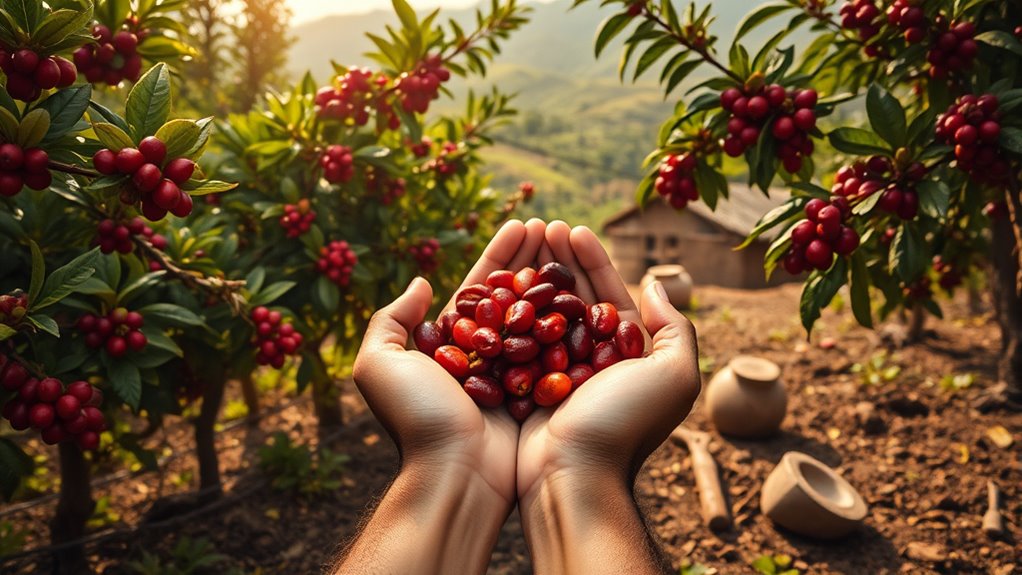
When you think about the origins of coffee, it’s fascinating to trace its beginnings back to Ethiopia’s Kefa region in the 9th century CE.
Kaldi, a goat herder, discovered coffee when he noticed his goats becoming energetic after eating coffee cherries.
By the 15th century, Sufi monks in Yemen began brewing this newfound beverage to stay awake during prayers. This early history set the stage for coffee’s spread across the Arabian Peninsula, where its popularity grew remarkably.
The emergence of coffee houses, or qahveh khaneh, created social hubs for music and news exchange.
When coffee made its way to Europe in the late 16th century, it initially faced skepticism until Pope Clement VIII embraced it, paving the way for widespread acceptance.
The Spread of Coffee Culture
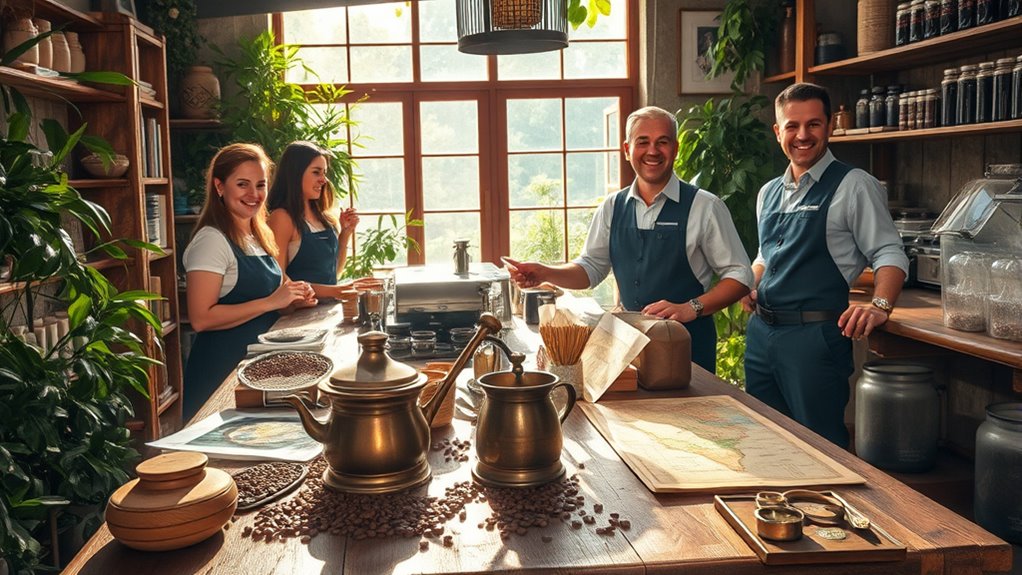
As coffee began to spread beyond its Ethiopian roots, its culture rapidly evolved into a global phenomenon.
By the 15th century, coffee cultivation took off on the Arabian Peninsula, reaching Yemen and further into the Middle East. Public coffee houses, or qahveh khaneh, emerged as lively centers for music, chess, and news sharing.
By the 17th century, coffee made its way to Europe, transforming into hubs for intellectual discussion despite initial skepticism.
After the Boston Tea Party in 1773, a national shift toward coffee consumption began in America, with New York City welcoming this new trend.
Coffee’s Journey to Europe and the Americas

As you explore coffee’s journey, you’ll find it transformed from a Middle Eastern drink to a European sensation in the late 16th century.
By the 17th century, coffeehouses became buzzing centers for conversation and debate, mirroring their Middle Eastern counterparts.
In the Americas, events like the Boston Tea Party shifted public taste, paving the way for coffee to become a symbol of patriotism and cultural identity.
European Coffee Houses
Although coffee faced skepticism upon its arrival in Europe in the late 16th century, it quickly captivated the continent, thanks in large part to Venetian merchants who introduced it.
Pope Clement VIII’s endorsement helped dispel negative perceptions, leading to the establishment of the first coffeehouses in England and beyond.
By the end of the 17th century, coffeehouses became essential social hubs in cities like London, where people gathered to exchange news, discuss politics, and engage in cultural activities.
The first English coffeehouse opened in 1652, and by the late 1600s, over 3,000 coffeehouses dotted the country, reflecting coffee’s rising popularity.
This surge foreshadowed coffee’s role as a symbol of patriotism during the American Revolution.
Coffee in the Americas
Coffee’s journey to the Americas began in the early 18th century when Gabriel de Clieu transported coffee seedlings from Martinique, sparking a wave of cultivation across the Caribbean.
By 1825, coffee cultivation spread to the Hawaiian Islands, enhancing the American colonies’ agricultural landscape.
The Boston Tea Party in 1773 shifted preferences, making coffee a patriotic alternative to British tea.
As coffeehouses thrived in Europe, they influenced social dynamics, eventually emerging in American cities.
By 1852, Brazil became the world’s largest coffee producer, meeting the rising global demand for coffee.
Major cultivation areas now include Brazil, Colombia, and Central American countries, each adapting practices to boost coffee production and contribute considerably to the global coffee market. This growth aligns with the sustainable fashion movement, as coffee cultivation increasingly focuses on eco-friendly practices to meet consumer demand.
Cultural Reception and Impact
When coffee first arrived in Europe during the late 16th century, it quickly captured the interest of merchants and consumers alike.
Introduced by Venetian traders from the Ottoman Empire, it became a cultural entity, leading to the rise of coffeehouses of Europe by the 17th century. These establishments fostered social interaction and intellectual exchange, boosting coffee’s popularity across every European country.
Pope Clement VIII’s approval of the beverage further dispelled suspicions, paving the way for widespread acceptance.
In colonial America, following the Boston Tea Party, coffee emerged as the patriotic choice over tea.
As coffee cultivation spread, particularly in the Caribbean, it transformed into a significant global commodity, with countries like Brazil and Colombia becoming leading producers by the 20th century.
Economic Impact and Global Trade
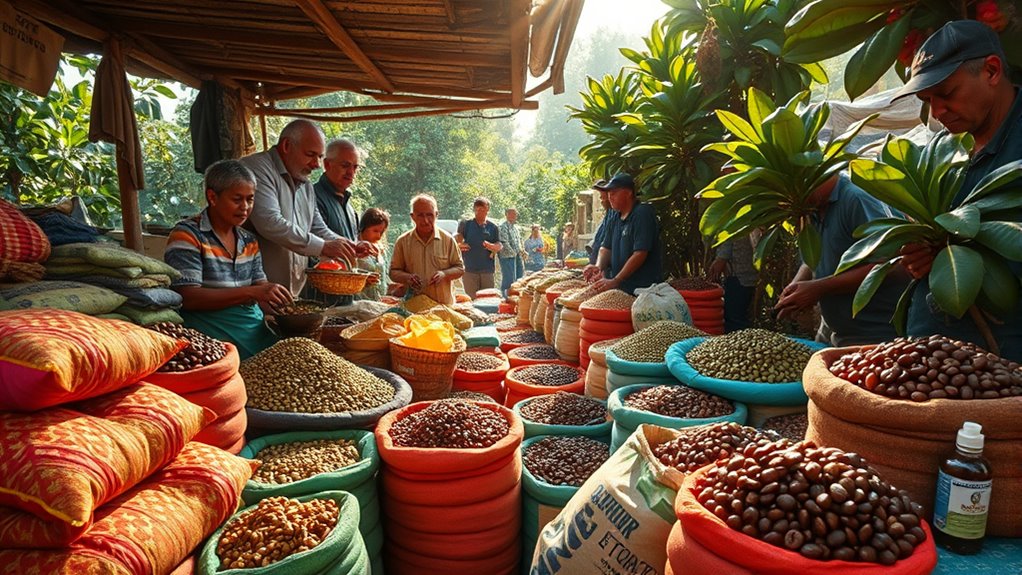
As you explore the economic impact and global trade of coffee, you’ll discover it’s one of the most lucrative international commodities. Coffee production primarily revolves around two main species: Arabica and Robusta.
With the United States leading in coffee consumption—brewing around 400 million cups daily—Brazil remains the world’s largest coffee producer since 1852, followed closely by Vietnam and Colombia.
This robust global trade network not only fuels economies but also influences social structures and trade routes. The growing interest in organic coffee and fair-trade practices reflects evolving consumer preferences, impacting production methods and trade dynamics.
Ultimately, coffee’s economic significance extends well beyond the cup, playing an essential role in international trade and shaping communities globally.
Etymology and Genetic Diversity of Coffee
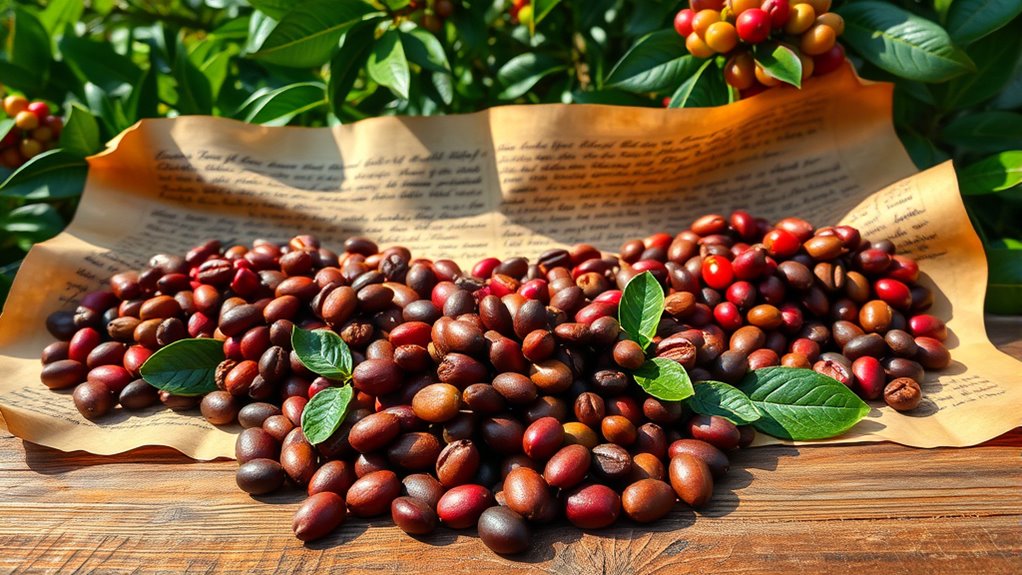
The fascinating journey of coffee begins with its name, which traces back through various languages and cultures. The English word “coffee” entered in 1582 from the Dutch “koffie,” rooted in the Ottoman Turkish “kahve,” and ultimately derived from the Arabic “qahwah,” meaning wine or intoxicating beverage.
This etymology highlights coffee’s stimulating effects, linked to the Arabic verb “qahiya,” which means to have no appetite.
Meanwhile, genetic studies of Coffea arabica reveal low genetic diversity, emphasizing the need for conservation and breeding programs to enhance resilience against pests and climate change.
The original coffee plant hails from Ethiopia’s Harar region, with local terms like “buna” reflecting its deep cultural significance and connection to the beans we cherish today.
The Evolution of Coffee Consumption and Culture
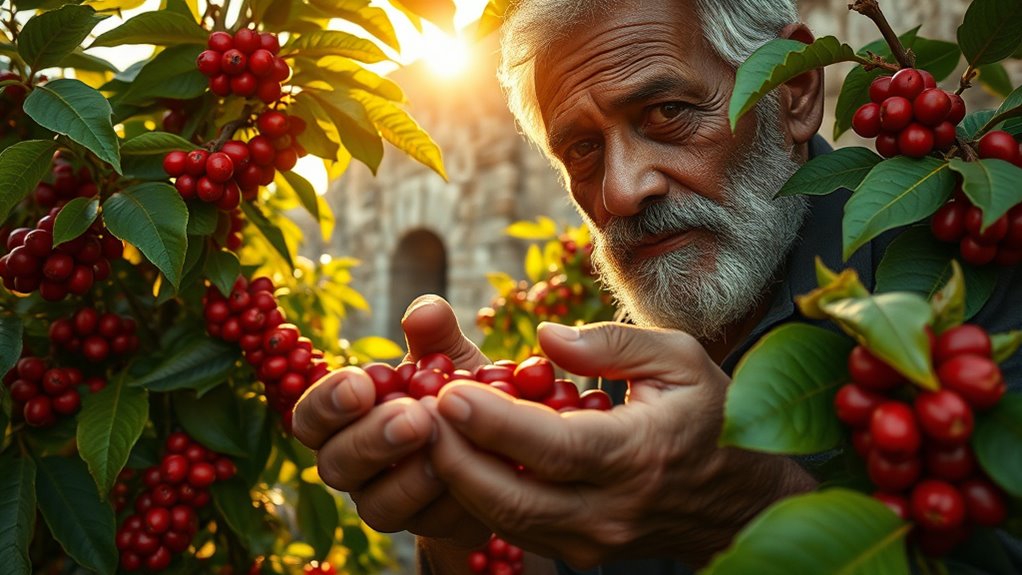
As you explore the evolution of coffee consumption and culture, you’ll find that coffeehouses transformed into vibrant cultural hubs, shaping social interactions throughout history.
The specialty coffee movement has redefined how you experience flavors and origins, making each cup a unique journey.
Today, global trends emphasize sustainability and ethical sourcing, reflecting a growing awareness of the impact your coffee choices have on the world.
Coffeehouse Cultural Hubs
Coffeehouses have long served as vibrant cultural hubs, shaping social interactions and community connections. Emerging in the Arabian Peninsula during the 15th century, these coffeehouses, known as qahveh khaneh, fostered music, performances, and the exchange of news. In these spaces, patrons often engaged in discussions about the supernatural realm, reflecting a curiosity that has persisted throughout history. Additionally, water parks in various regions have become modern-day community centers, similar to how coffeehouses once functioned. Furthermore, these venues often featured curated messages and conversations that reinforced community bonds and personal connections.
By the late 17th century, they transformed into centers of political discourse and intellectual exchange in Western Europe, particularly in England. Venetian merchants played an essential role in introducing coffee to Europe, and with Pope Clement VIII’s endorsement, coffee gained legitimacy and popularity.
In the Americas, following the Boston Tea Party in 1773, coffee became the preferred beverage. Today, specialty coffee shops continue this legacy, emphasizing quality and sustainability while engaging communities in meaningful ways. Additionally, coffee’s health benefits, such as its ability to combat oxidative stress, have contributed to its enduring popularity as a beverage choice.
Specialty Coffee Movement
Emerging in the late 20th century, the Specialty Coffee Movement transformed how many people experience and appreciate coffee. You now have access to high-quality, sustainably sourced beans that highlight distinct flavor profiles tied to their origins.
This movement emphasizes transparency in the coffee supply chain, promoting direct trade between farmers and roasters to guarantee fair compensation for growers. As you visit specialty coffee shops, you’ll notice artisanal brewing methods, like pour-over and siphon brewing, allowing you to savor each coffee’s unique characteristics.
The rise of the Specialty Coffee Association has further connected coffee professionals, fostering education and community. With 55% of American coffee drinkers identifying as specialty coffee consumers, it’s clear the movement has profoundly impacted coffee culture.
Global Coffee Trends
While coffee consumption has deep roots in various cultures, its evolution over the years has dramatically shaped how you enjoy your daily brew.
The global coffee market has seen significant changes, influenced by a demand for high-quality coffee and sustainability. Here are some trends you might find interesting:
- The rise of specialty coffee shops and artisan roasters focusing on unique brews.
- A shift from mass-produced coffee to a culture that celebrates artisanal production.
- Coffeehouses transforming into spaces for political discourse and community engagement.
- Emphasis on ethically sourced beans from top producers like Brazil and Colombia.
As these trends continue, they redefine coffee culture, making every cup not just a drink, but a narrative of history, quality, and connection.
Frequently Asked Questions
Where Did Coffee Originally Come From?
Coffee originally comes from the Kefa region of Ethiopia, where wild coffee plants thrive.
You might find it interesting that the legend of Kaldi, a goat herder, tells how he discovered coffee’s energizing effects after noticing his goats’ unusual energy.
By the 15th century, coffee cultivation spread to Yemen, where it became popular among Sufi monks.
This journey laid the groundwork for coffee’s global popularity that followed in the centuries to come.
How Did Humans Start Drinking Coffee?
Drinking coffee started like a spark igniting curiosity in the dark. In the 15th century, Sufi monks in Yemen brewed it to stay alert during prayers, discovering its energizing effects.
Soon, coffeehouses sprang up, buzzing with conversations and music, making coffee a social staple.
Did Coffee Originate in Yemen or Ethiopia?
You might wonder whether coffee originated in Yemen or Ethiopia.
Well, both regions are pivotal to coffee’s history. Ethiopia is often credited as the birthplace of the coffee plant, linked to the legend of Kaldi.
However, Yemen is where coffee cultivation truly began, as it was the first place to commercialize coffee as a beverage.
What Are 7 Facts About Coffee You Didn’t Know?
Did you know that over 2.25 billion cups of coffee are consumed worldwide every day?
Here are seven facts you mightn’t know: coffee beans aren’t beans; they’re seeds. Arabica beans make up about 60-70% of global production.
The first coffeehouse opened in Istanbul in 1475. Coffee was once banned in Mecca for its stimulating effects.
Decaf coffee still contains some caffeine. The world’s most expensive coffee is Kopi Luwak.
Finally, coffee can help improve your mood!
Conclusion
In the grand tapestry of history, coffee weaves a rich narrative that connects us all. From its humble beginnings in ancient Ethiopia to its vibrant presence in today’s cafes, this beloved brew has transformed lives and cultures. As you sip your next cup, remember you’re part of a timeless journey—an aromatic dance of discovery, trade, and connection. So, raise your mug and toast to the enduring legacy of coffee, a timeless companion on life’s flavorful adventures.
